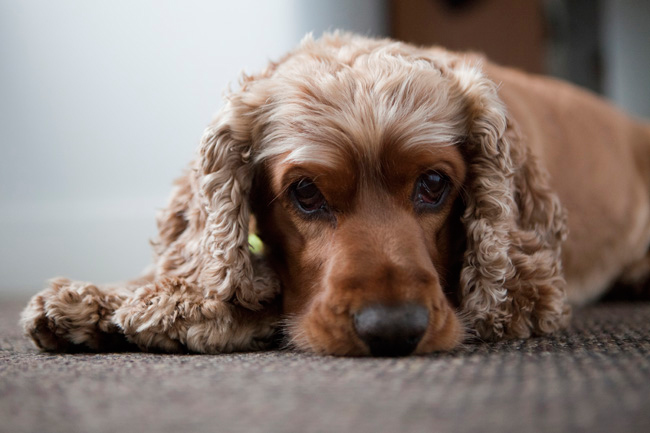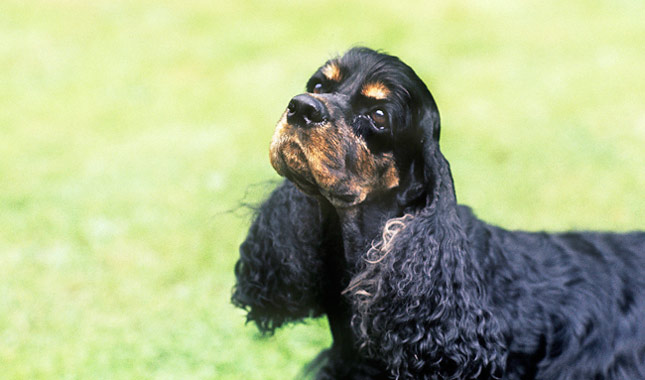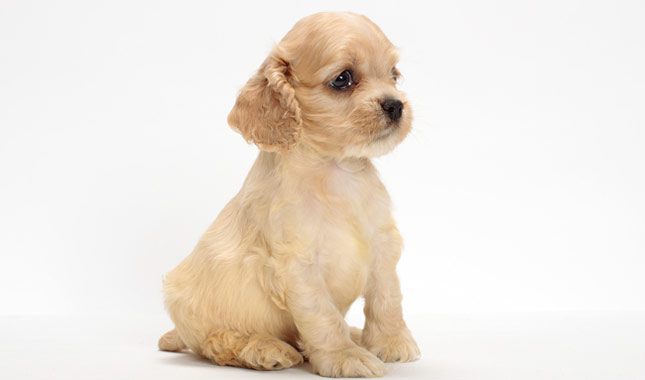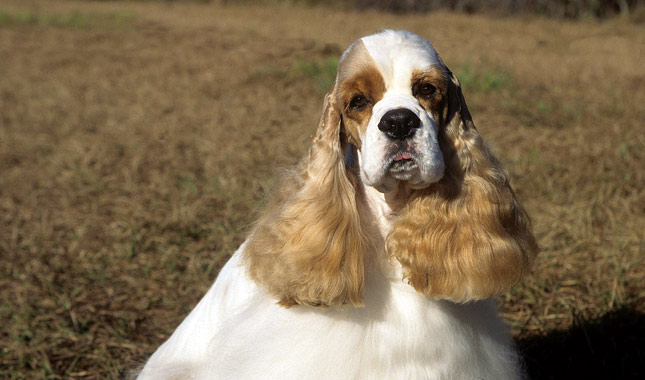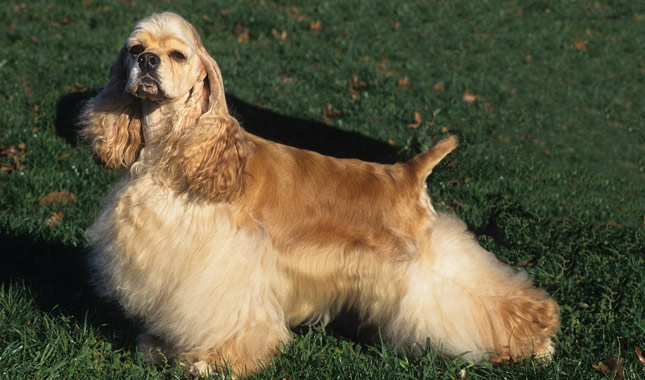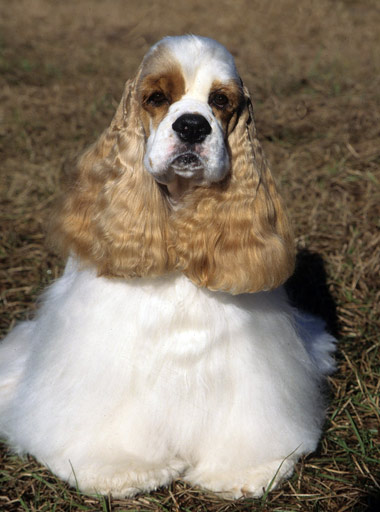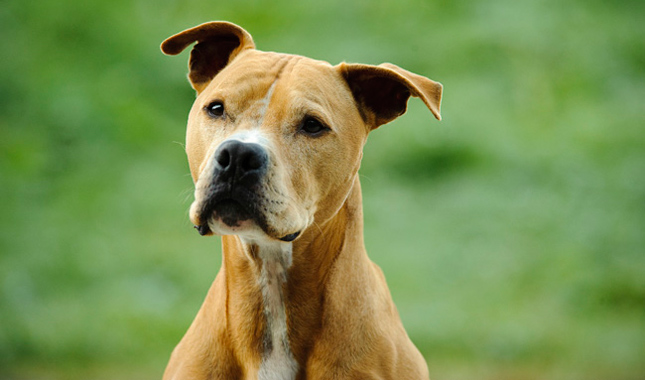Cocker Spaniel
Published on June 23, 2011
Breed Details
- Height: 14 to 15 inches at the shoulder
- Weight: 20 to 30 pounds
Breed Characteristics
Adaptability
Trainability
Grooming
Apartament Friendly
Child Friendly
Shedding Level
Dog Friendly
Exercise Needs
Territorial
Barking Tendencies
Health Issues
Social Needs
Energy Level
Affectionate
Watchdog Instincts
Cat Friendly
Intelligence
Stranger Friendly
Before the Golden Retriever and Labrador set the modern bar for the “great with kids” family companion, no breed was more beloved or popular than the Cocker Spaniel. Beautiful, sweet-natured and moderately sized, the Cocker’s popularity bounded happily forward after World War II with the two-time Westminster Best in Show winner Ch. My Own Brucie. At his best, the Cocker is a gentle, affectionate and healthy dog with soft, dark eyes.
Weighing less than 30 pounds (albeit with a tendency to gain more) with a soft, wavy coat in many colors and patterns, long ears and the most expressive eyes in dogdom, the Cocker is an excellent family pet — lively, affectionate, sweet and trainable. But at his worst, he's a nightmare. Popularity has truly been a curse to the Cocker Spaniel, and he's one of the favorite breeds of puppy millers, Internet retailers, and pet stores, who sell sad-eyed, floppy-eared, adorable puppies that too often grow up to be unstable, noisy, nervous dogs who are difficult to housetrain and have a tendency to snap and even bite.
If you're lucky enough to find a puppy from a good breeder, get him off on the right foot with gentle and consistent training right from the start. A well-bred Cocker should be easy to housetrain, happy to be with you, and eager to experience new things even if it means walking on a leash, riding in the car or going to puppy classes.
Because Cocker Spaniels are extremely people-oriented, even the best-bred and socialized dogs tend to be a bit unhappy when left alone. For some, this takes the form of full-blown separation anxiety, with the barking, crying, and destructive behavior that usually accompanies it. Accustom your dog from puppyhood to being left alone from time to time. However, if you expect long hours left on his own to be part of your dog’s usual routine, this is probably not the breed for you.
Cocker Spaniels are typically friendly with other dogs and with cats. They are moderate shedders, and their coats require brushing several times a week. They can also be kept clipped, in which case they'll need to be professionally or home-groomed every four to six weeks.
While the Cocker Spaniel is on the small side, don’t forget that he is a Sporting breed. Although he doesn’t need the hard-core exercise of some of the other sporting breeds, he still needs to burn off a lot of steam as he could run all day – after all, he’s bred to do so. However, a half hour walk or game of fetching the ball once or twice a day is appropriate, although he’d love to go on longer walks with you. You could also substitute a solid 15 minutes per day of obedience training, which stimulates his mind as well as his body. He’s a busy little guy, sniffing all day to follow a scent.
The different colors within the breed are considered separate varieties. A Black Cocker includes solid black as well as black and tan. The acronym ASCOB stands for "any solid color other than black,” which can include buff, brown, silver, and so on. The parti-color Cocker is either black and white, brown and white, red and white, or tri-color.
Cocker Spaniels are first and foremost companion dogs and should not live outdoors. They need to live in the house with you and your family.
Other Quick Facts
- Loving, affectionate and gentle, a well-bred Cocker is a terrific family pet and fits comfortably into any size home.
- A poorly bred Cocker is snappy and afraid of people. This breed is one in which it pays to work with a responsible, experienced breeder.
- The Cocker can compete in field trials, hunt tests, obedience, rally, agility, freestyle, and other forms of dog performance activities. He makes a good therapy dog.
- The Cocker tail is typically docked, or cut short, when puppies are three or four days old. This is a point of controversy to some because it is a cosmetic procedure, although people in the breed note that it helps protect the tail from injury in the field.
- Even well-bred Cockers are sensitive, so it’s important to use positive reinforcement and praise during training.
The History of Cocker Spaniels
References to "Spanyells" date to the 14th century. Different types of spaniels evolved over the centuries, some working on land and some retrieving from water. The Cocker, which flushes game and retrieves it under command, derives his name from his skill at hunting woodcock, a type of wading bird. He is the smallest dog in the Sporting Group.
Spaniels used to be classified by size, and different types of spaniels might be born in the same litter. Eventually, the various spaniel types became individual breeds, and so it was with the Cocker. By 1946 the size and appearance of the Cocker and what is now the English Cocker Spaniel had changed enough that the two were split off into separate breeds.
The popularity of the Cocker skyrocketed after the release of Disney’s classic movie “Lady and the Tramp” in 1955. The immense popularity fueled a rise in poor breeding that resulted in some bad temperaments, but Cocker breeders have worked hard to correct the situation. It is still important today, however, to find a responsible breeder who maintains the breed’s hallmark cheery disposition rather than continuing to put out the fearful and snappish dogs that nearly ruined the breed.
Until 1990, the Cocker was the most popular breed registered by the American Kennel Club. Today he ranks 25th, but he will always have a place among people who appreciate his moderate size, sweet nature and intelligence.
Cocker Spaniel Temperament and Personality
Merry and lively, the Cocker Spaniel is also intelligent and trusting. Although he still retains a strong instinct to hunt, he is most often a house companion. With his family he is affectionate and docile. He can be a bit reserved at first with strangers, but he soon makes friends. Cockers can be good companions for children: not so big that they bowl them over and not so small that they are easily harmed by them. When raised together, they can buddy up with other pets, including cats, but birds may be an irresistible lure — and not in a good way.
The Cocker is highly trainable, but he has a sensitive soul. Early socialization is critical, and even with it some Cockers will urinate submissively when their people come home or when they meet new people or dogs or go new places. Approach training with positive reinforcement methods, especially praise and food rewards.
The Cocker can be good at field trials and as a gun dog, although for years he was thought of as "just" a companion. A Cocker is versatile and can do so much more than just hanging around the house, but he's quite content to do that too because he loves being with you.
Any dog, no matter how nice, can develop obnoxious levels of barking, digging and other undesirable behaviors if he is bored, untrained or unsupervised. And any dog can be a trial to live with during adolescence. In the case of the Cocker, the “teen” years start at six months and continue until the dog is about a year old. His barking can be a problem unless you curb it early.
Start training your puppy the day you bring him home. Even at eight weeks old, he is capable of soaking up everything you can teach him. Don’t wait until he is 6 months old to begin training or you will have a more headstrong dog to deal with. If possible, get him into puppy kindergarten class by the time he is 10 to 12 weeks old, and socialize, socialize, socialize. However, be aware that many puppy training classes require certain vaccines (like kennel cough) to be up to date, and many veterinarians recommend limited exposure to other dogs and public places until puppy vaccines (including rabies, distemper and parvovirus) have been completed. In lieu of formal training, you can begin training your puppy at home and socializing him among family and friends until puppy vaccines are completed.
Talk to the breeder, describe exactly what you’re looking for in a dog, and ask for assistance in selecting a puppy. Breeders see the puppies daily and can make uncannily accurate recommendations once they know something about your lifestyle and personality.
The perfect Cocker Spaniel doesn’t spring fully formed from the whelping box. He’s a product of his background and breeding. Cockers have been overbred in the past, sometimes resulting in a fearful, slightly scary dog that in no way represents a well-bred Cocker. Look for one whose parents have nice personalities and who has been well socialized from early puppyhood.
What You Need to Know About Cocker Health
All dogs have the potential to develop genetic health problems, just as all people have the potential to inherit a particular disease. Run, don’t walk, from any breeder who does not offer a health guarantee on puppies, who tells you that the breed is 100 percent healthy and has no known problems, or who tells you that her puppies are isolated from the main part of the household for health reasons. A reputable breeder will be honest and open about health problems in the breed and the incidence with which they occur in her lines. Here’s a brief rundown on what you should know about the Cocker’s health.
Cocker Spaniels are susceptible to a number of health problems that are at least partly genetic. These include many different eye disorders including cataracts and glaucoma, as well as painful defects of the hips and knees.
Disc disease can make movement painful for the Cocker Spaniel, who is by nature an active dog who loves to run and play. Heart disease, liver disease, epilepsy – the Cocker is at risk for all of them.
The variety of eye problems that can afflict the Cocker Spaniel ranges from the cosmetic – a condition called "cherry eye" that can be corrected by surgery – and the sight-threatening, including cataracts and glaucoma. While many Cockers lose their vision entirely in old age, some can lose their sight as early as two years of age due to progressive retinal atrophy. Cockers are also prone to keratoconjunctivitis sicca, a condition known as dry eye, a deficiency of tears that can lead to corneal problems.
Make sure to have your Cocker Spaniel's eyes examined once a year by a board-certified veterinary ophthalmologist, and seek veterinary care immediately at any signs of vision loss, cloudiness, redness, irritation of the eyes or if the dog is squinting or pawing at them.
Cockers can also have hypothyroidism, which is the underproduction of thyroid hormone. This can cause weight gain, lethargy, hair loss, shivering and skin infections. Cockers should have their thyroids checked with a simple blood test any time thyroid disease is suspected. Skin problems may also indicate allergies, which are common in the breed, as are skin masses, which may be benign or cancerous.
Some Cocker Spaniels seem to be prone to congenital deafness, associated with white hair and blue eyes. At the age of three or four weeks, in some of these dogs the blood supply to the inner ear degenerates. It can occur in one or both ears and is permanent.
Those long spaniel ears tend to trap warm, moist air inside the ear canals, creating the perfect environment for growth of bacteria and yeast, which lead to ear infections. Ear infections can be chronic in some dogs with long ears, so it’s necessary to stay on top of ear care and clean them religiously. Repeated infections can cause so much damage to the ear canal that the dog will lose his hearing. Severely affected ears may require surgery. Follow-up care is especially important in matters of the ear to prevent new flare-ups of old problems.
Cockers have more autoimmune diseases than many other breeds, for reasons that aren't clear.Many Cocker Spaniels are prone to autoimmune hemolytic anemia (AIHA), in which the dog's immune system attacks his own red blood cells to the point that the dog becomes anemic. While there is treatment, the mortality rate is high.
Not all of these conditions are detectable in a growing puppy, and it is impossible to predict whether an animal will be free of these maladies, which is why you must find a reputable breeder who is committed to breeding the healthiest animals possible. They should be able to produce independent certification that the parents of the dog (and grandparents, etc.) have been screened for common defects and deemed healthy for breeding. That’s where health registries come in.
Before individual Cockers can be included in the Canine Health Information Center (CHIC) database, the ASC requires them to have a clearance from the Canine Eye Registry Foundation or a board-certified veterinary ophthalmologist (to check for cataracts, glaucoma, and progressive retinal atrophy); hip evaluations from the Orthopedic Foundation for Animals or PennHIP; a thyroid profile; and a profile for blood factor X and von Willebrand’s disease. You can search the OFA and CHIC websites yourself to see if a pup’s parents are listed.
Breeders must agree to have all test results, positive or negative, published in the CHIC database. A dog need not receive good or even passing scores on the evaluations to obtain a CHIC number, so CHIC registration alone is not proof of soundness or absence of disease, but all test results are posted on the CHIC website and can be accessed by anyone who wants to check the health of a puppy’s parents. If the breeder tells you she doesn't need to do those tests because she's never had problems in her lines and her dogs have been "vet checked," then you should go find a breeder who is more rigorous about genetic testing.
Careful breeders screen their breeding dogs for genetic disease and breed only the healthiest and best-looking specimens, but sometimes Mother Nature has other ideas and a puppy develops one of these diseases despite good breeding practices. Advances in veterinary medicine mean that in most cases the dogs can still live a good life. If you’re getting a puppy, ask the breeder about the ages of the dogs in her lines and what they died of.
Remember that after you’ve taken a new puppy into your home, you have the power to protect him from one of the most common health problems: obesity. Keeping a Cocker Spaniel at an appropriate weight is one of the easiest ways to extend his life. Make the most of your preventive abilities to help ensure a healthier dog for life.
The Basics of Cocker Grooming
The beautiful, silky Cocker coat that you see on dogs in the show ring doesn’t just happen. It takes a lot of work to keep it shiny and tangle-free. For good reason, most people keep their pets in a short cut all over, known as a puppy cut. Even that requires a fair bit of maintenance. Dogs with puppy cuts should be bathed, brushed and trimmed about every two weeks.
If you want the flowing long coat, more care and time must be taken, and typically the bathing, brushing and trimming happens once a week. Most people choose to take their Cocker to a professional groomer, but you can learn to do it yourself. The cost of the equipment is equivalent to only a few grooming sessions, you won’t have to schedule appointments and you will find that you increase your bond with your Cocker. However, grooming isn’t for everyone, so if you don’t want to do it, find a groomer you like because it’s an absolute requirement for a Cocker.
Because Cocker ears are prone to infection, check them weekly to make sure the inside is a healthy, vibrant pink and doesn’t have a foul odor. If not, get to the vet quickly before the ear infection becomes a major issue. Be particularly careful to check the ears of a puppy as there is a significant wax buildup while the ear canal develops. Clean the ears using a solution recommended by your veterinarian.
The rest is basic care. Trim the toenails every few weeks. They should never get long enough that you hear them clacking on the floor. Long nails can make it uncomfortable for the Cocker to walk, and they can get caught on things and tear off. That’s really painful, and it will bleed a lot. Brush the teeth frequently for good dental health and fresh breath.
Finding a Cocker Spaniel
Whether you want to go with a breeder or get your dog from a shelter or rescue, here are some things to keep in mind.
Choosing a Cocker Spaniel Breeder
Finding a good breeder is the key to finding the right puppy. A good breeder will match you with the right puppy, and will without question have done all the health certifications necessary to screen out health problems as much as is possible. He or she is more interested in placing pups in the right homes than in making big bucks.
Good breeders will welcome your questions about temperament, health clearances and what the dogs are like to live with and come right back at you with questions of their own about what you’re looking for in a dog and what kind of life you can provide for him. A good breeder can tell you about the history of the breed, explain why one puppy is considered pet quality while another is not, and discuss what health problems affect the breed and the steps she takes take to avoid those problems.
Find a breeder who is a member in good standing of The American Spaniel Club, Inc. and who has agreed to abide by its code of ethics, which prohibits selling dogs to or through pet stores. Your Cocker breeder should want to be a resource in helping you train and care for your new dog.
Avoid breeders who only seem interested in how quickly they can unload a puppy on you and whether your credit card will go through. You should also bear in mind that buying a puppy from websites that offer to ship your dog to you immediately can be a risky venture, as it leaves you no recourse if what you get isn’t exactly what you expected. Put at least as much effort into researching your puppy as you would into choosing a new car or expensive appliance. It will save you money in the long run.
Many reputable breeders have websites, so how can you tell who’s good and who’s not? Red flags include puppies always being available, multiple litters on the premises, having your choice of any puppy, and the ability to pay online with a credit card. Those things are convenient, but they are almost never associated with reputable breeders.
Whether you’re planning to get your new best friend from a breeder, a pet store, or another source, don’t forget that old adage “let the buyer beware”. Disreputable breeders and facilities that deal with puppy mills can be hard to distinguish from reliable operations. There’s no 100% guaranteed way to make sure you’ll never purchase a sick puppy, but researching the breed (so you know what to expect), checking out the facility (to identify unhealthy conditions or sick animals), and asking the right questions can reduce the chances of heading into a disastrous situation. And don’t forget to ask your veterinarian, who can often refer you to a reputable breeder, breed rescue organization, or other reliable source for healthy puppies.
The cost of a Cocker puppy varies depending on where the breeder lives, whether he is male or female, what titles his parents have, and whether he is best suited for the show ring or a pet home. Expect to pay between $300 and $1,000 for a puppy. The puppy you buy should have been raised in a clean home environment, from parents with health clearances and conformation (show) and, ideally, working titles to prove that they are good specimens of the breed. Puppies should be temperament tested, vetted, dewormed, and socialized to give them a healthy, confident start in life.
Before you decide to buy a puppy, consider whether an adult Cocker Spaniel might better suit your needs and lifestyle. Puppies are loads of fun, but they require a lot of time and effort before they grow up to become the dog of your dreams. An adult Cocker may already have some training and will probably be less active, destructive and demanding than a puppy. With an adult, you know more about what you’re getting in terms of personality and health and you can find adults through breeders or shelters. If you are interested in acquiring an older dog through breeders, ask them about purchasing a retired show dog or if they know of an adult dog who needs a new home. If you want to adopt a dog, read the advice below on how to do that.
Adopting a Dog from a Cocker Spaniel Rescue or Shelter
There are many great options available if you want to adopt a dog from an animal shelter or breed rescue organization. Here is how to get started.
1. Use the Web
Sites like Petfinder.com and Adopt-a-Pet.com can have you searching for a Cocker in your area in no time flat. The site allows you to be very specific in your requests (housetraining status, for example) or very general (all the Cockers available on Petfinder across the country). AnimalShelter can help you find animal rescue groups in your area. Also some local newspapers have “pets looking for homes” sections you can review.
Social media is another great way to find a dog. Post on your Facebook page that you are looking for a specific breed so that your entire community can be your eyes and ears.
2. Reach Out to Local Experts
Start talking with all the pet pros in your area about your desire for a Cocker. That includes vets, dog walkers, and groomers. When someone has to make the tough decision to give up a dog, that person will often ask her own trusted network for recommendations.
3. Talk to Breed Rescue
Networking can help you find a dog that may be the perfect companion for your family. You can also search online for other Cocker rescues in your area. Most people who love Cockers love all Cockers. That’s why breed clubs have rescue organizations devoted to taking care of homeless dogs. The American Spaniel Club’s rescue network can help you find a dog that may be the perfect companion for your family. You can also search online for other Cocker rescues in your area.
The great thing about breed rescue groups is that they tend to be very upfront about any health conditions the dogs may have and are a valuable resource for advice. They also often offer fostering opportunities so, with training, you could bring a Cocker home with you to see what the experience is like.
4. Key Questions to Ask
You now know the things to discuss with a breeder, but there are also questions you should discuss with shelter or rescue group staff or volunteers before you bring home a pup. These include:
What is his energy level?
How is he around other animals?
How does he respond to shelter workers, visitors and children?
What is his personality like?
What is his age?
Is he housetrained?
Has he ever bitten or hurt anyone that they know of?
Are there any known health issues?
Wherever you acquire your Cocker Spaniel, make sure you have a good contract with the seller, shelter or rescue group that spells out responsibilities on both sides. Petfinder offers an Adopters Bill of Rights that helps you understand what you can consider normal and appropriate when you get a dog from a shelter. In states with “puppy lemon laws,” be sure you and the person you get the dog from both understand your rights and recourses.
Puppy or adult, take your Cocker to your veterinarian soon after adoption. Your veterinarian will be able to spot problems, and will work with you to set up a preventive regimen that will help you avoid many health issues.

